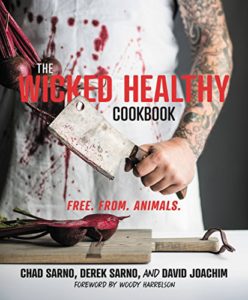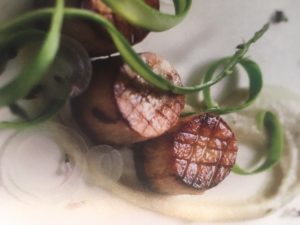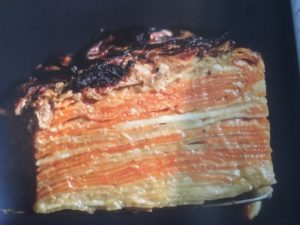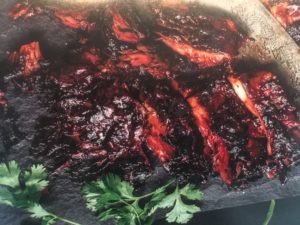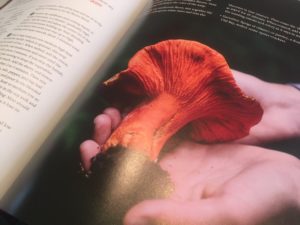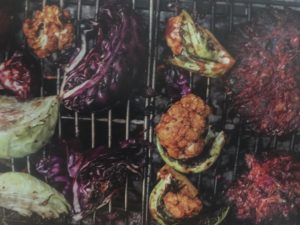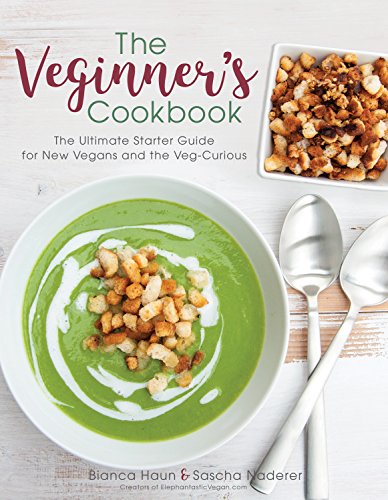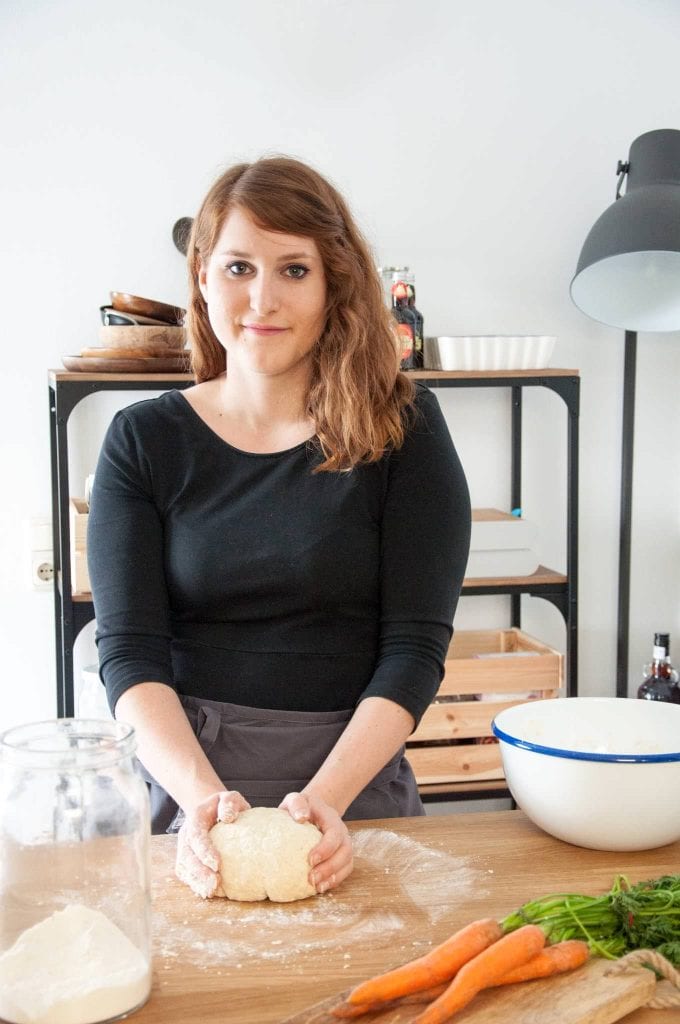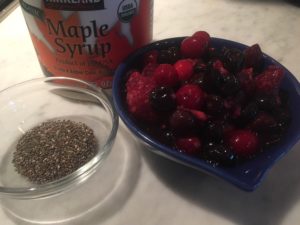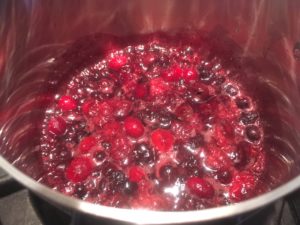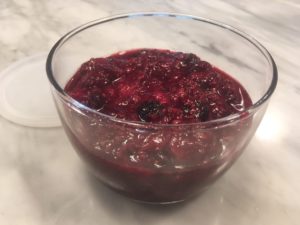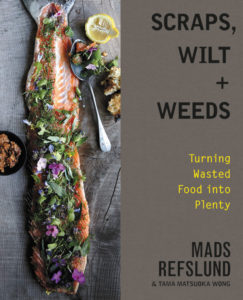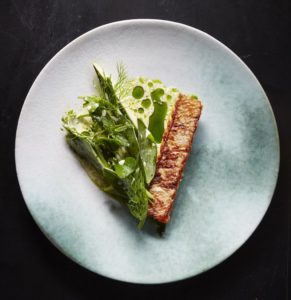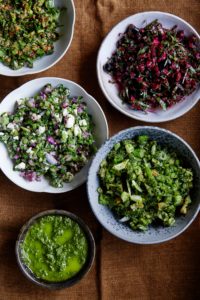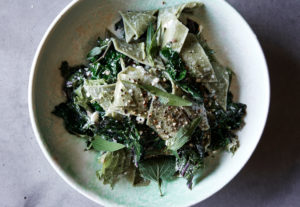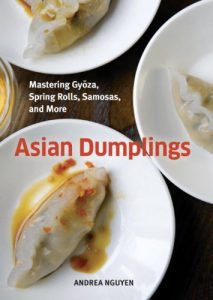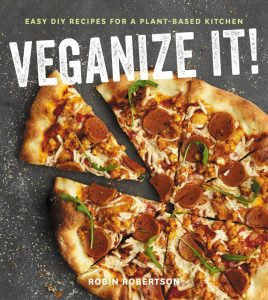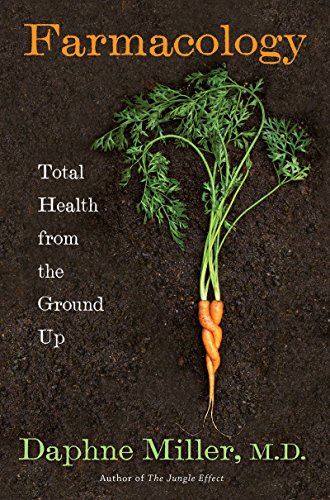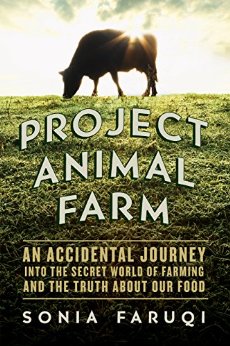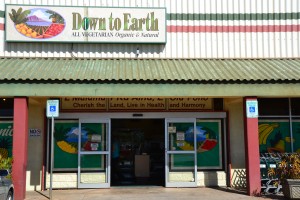Category Archives: Food Resources
The Wicked Healthy Cookbook – Free. From. Animals. (Preliminary Review)
By Chad Sarno, Derek Sarno, and David Joachim
Grand Central Life & Style, Hachette Book Group, New York, NY 2018 $30
I love this book!!! From the minute it arrived, I was lost. Just skimming the essays, lists, Pro Tips and stunning recipes and images took me into the wee hours. Putting it down was not an option. Granted, my guilty pleasure is reading cookbooks. But this is a very special tome. Just when it felt like plant-based cuisine had reached its limits, with book after book adding a few new spins but churning the same ground, Wicked Healthy has seriously upped the ante. It’s fun, exciting, innovative, energetic, – the enthusiasm for the possibilities of plant-based gastronomy leaps off the pages. Dust off that mandoline!
To be clear this is not a book for every veg-forward cook. It is not an intro to the philosophy or a beginners’ guide. Some of the recipes are challenging, time-consuming and utilize esoteric ingredients that may require the resources of Whole Foods, Amazon, H-Mart, Thrive, a sophisticated farmers market and a few small mail-order houses – and even then you may have to be satisfied with recommended subs. It’s also, not surprisingly, a bit cheffy – many ingredients lists include other recipes so, unless you have a staff, there is sometimes serious time required. But it will be well-spent, satisfying time – even the process of discovering new or less-available ingredients will be well-spent, satisfying time. Bottom line, if all you do is just read The Wicked Healthy Cookbook, you can’t help but appreciate the expanded possibilities of plant-based cookery.
This is just my first review. I am going to cook my way through a good chunk of the book and post the results as I go. Starting with their bold new take on mushrooms: King Oysters, Maitakes, and Lobsters. What fun!! I can’t wait.
(One question – olive oil instead of avocado oil for high heat cooking?)
The Veginner’s Cookbook – The Ultimate Starter Guide for New Vegans and the Veg-Curious
by Bianca Haun and Sascha Naderer
Skyhorse Publishing, January 16. 2018
My first reaction to this beautifully photographed, inviting tome was “What a great name! How come no one else thought it?” And it is actually a perfect name. This is a nicely done intro to vegan food. If you have been cooking and eating a plant-based diet for a while, or are deep into the various nutritional perspectives, you might not find a lot new here. But if you are thinking about dipping a toe in the vegan waters, it’s a very solid beginning.
All of the culinary bases are covered; the authors provide a current overview of the plant-based landscape – and have even included a couple of “finds” like kala namak (Himalayan black salt) for an eggy taste. The full-page color photos of the finished dish are excellent – and really required for beginners. The goal is clearly to ease the first-timer into the concept of meat and dairy-free cooking and eating without adding the additional challenges of limiting some oils or using only whole grains and whole-foods. It is a reasonable approach.
The authors, Bianca & Sascha, are an Austrian couple who are passionate about their relatively recent adoption of veganism and share their experiences on their blog ElephantasticVegan.com as well as in this new book. They also provide a little hard-won guidance for newbies who are navigating the sometimes treacherous social waters of “well a little won’t hurt, will it?” or “where do you get your protein?” Sascha calls it the “Landmine Situations.”
We also appreciate the Bianca’s Kitchen Hacks that are scattered throughout the book. These are little hints for the newbie and some additional thoughts for the more experienced.
Be aware: The nutritional philosophy that underlies their book is straight-ahead vegan (as opposed to whole-foods, plant-based): veggies, grains, nuts, seeds, oils (especially canola oil* – which is concernful). You won’t find a lot of whole grains, gluten-free or sugar/sweetener-free recipes. Their main concern with white sugar, for instance, is that it is vegan (and not made with bone char) rather than that is may be very bad for your health. Baking begins with white all-purpose flour with a nod to some options (that said Healthy Breakfast Muffins are made with oat flour). That is not a criticism as much as a buyer-aware alert. (Also for recipes that contain miso, be sure not to let it boil or you will kill off the probiotics.)
We love the Small-Batch Strawberry Chia Jam – quick and easy and delicious (so convenient when you discover you’ve just run out – see images below). The last time I used frozen organic mixed berries with a smidge more maple syrup. And the curries are inventive and easy, as well. The Hummus Four Ways are strikingly beautiful and the Shake and Bake Sweet Potato Fries inspiring (a keeper in this house)! Love the banana-based “Nice Creams”, too. I am surprised by the canned lentils in the Thyme Lentil Soup (unless you are on a Low FOD-MAP diet). Dried lentils would have taken just another 15 or so minutes.
Bottom line: This would make a great gift for someone who has expressed interest in experimenting with a plant-based diet. The recipes will be successful and delicious – and visually appealing. It will get most people over the hump and show them that this is a viable diet. And, even if they don’t go the whole way, they will have found a lot of recipes that will stay in their rotation no matter what.
(*Canola Oil – perhaps the canola oil available in Austria is less tainted than what we can get in the US. I substituted Avocado oil or Coconut oil for the canola oil in the recipes that I tried. Also subbed tomato sauce or tomato puree for tomato passata.)
Glorious Food Waste
For decades, I have been gently chided, and occasionally mocked, for my kitchen frugality. A drawer filled with wilting produce sets off a visceral reaction leading to aggressive cooking. I don’t think it’s cheapness, as much as it’s a deep-seated concern about waste. Over the years, cooking teachers have denigrated the big, re-purposed Ziplock in my freezer chock full of plant scraps and leavings; apparently only pristine produce is good enough to make vegetable stock or fruit sauces. But still I persisted because, frankly, that just didn’t make any sense to me. And, besides, I just can’t empty that seemingly still good food into the trash or compost heap.
A short while ago, I stumbled on a wonderful “cookbook” Scraps, Wilt + Weeds written by Mads Refslund and Tama Matsuoka Wong. Refslund was a co-founder of world-famous Danish restaurant, Noma, and, shockingly, shares my visceral reaction to wilting, near-rotting produce! But he goes many steps beyond just making vegetable stock, dry-roasting just-past-prime produce, stewing less than perfect fruit into sauces and, of course, freezing very ripe bananas for breads and smoothies. Mads Refslund has elevated waste to haute cuisine.
The concepts are invigorating and inspirational – with stunning photographs that make near garbage extraordinarily beautiful. I use the word concept advisedly – to me the recipes are more conceptual than standard “multi-user-tested” ones. This is relatively new turf and the reader needs more guidance as to when, for instance, a tomato is near rot or just plain rotten. Even though I am a fairly accomplished home cook and long-time rescuer of wilted produce, I often had questions. For instance, a couple years ago I made carrot-top pesto from gorgeous, young CSA carrots and it was so bitter, it was inedible – why wasn’t his?
On the other hand, he encourages flexibility – use what you have (less, more or sub something else) rather than create more waste by buying to meet the specific recipe requirements. Other chapters focus on buying “ugly” produce, foraging for “weeds” and even using discarded fish parts. All told, it is a glorious paean to the minimization of waste and as I reluctantly released my non-renewable library copy, I concurrently added it to my Amazon list.
Mads Refslund has vindicated my kitchen frugality while he introduced others on whose shoulders he stands; those who have been long proselytizing waste reduction but who did not have his bully pulpit**. He has made reducing food waste sexy and chic. What a stunning, unbelievable accomplishment!! This is a book to own – a reference to stiffen our spines and alter our perceptions when we are about to sweep the leavings into the Waste King or the compost pot.
Why is this book so important? Every year, roughly 30% of all the food raised on the planet for human ingestion is literally wasted. If you just look at first world countries that number is even higher with the U.S. leading the pack at over 40%. According to the World Economic Forum, our global population is projected to reach 9.6 billion by 2050 – raising the leading question: how do we feed everybody? The United Nation’s FAO (Food & Agriculture Organization) posits that we already grow enough food, we just have to figure out how to save that 30-40% that we are currently wasting – which represents about 28% of the earth’s agricultural land. A whopping 25 percent of that waste is imperfect produce left in the fields to rot and 15% comes from tossed out, perfectly edible, food. (An additional, crucial, benefit would be to save the carbon footprint of all that wasted food –according to the EPA, landfills account for 34% of all U.S. methane emissions.)
** I am reading some of the author’s references and will share reviews and content in future posts.
My Take on “Veganism”
Up until a dozen years ago, we’d been innocently and happily eating a whole-foods, sugar-free, “healthy diet” for about three decades; it included low-fat dairy, white meat chicken and fish. But then, my husband “pushed through” on a New York Marathon feeder race, collapsed and was unceremoniously hauled off to a local hospital. That was when we learned that he had plaque on his arteries! I took this as a personal affront to my hard-won nutritional knowledge and culinary expertise.
After listening to my angst-ridden breast-beating, a friend handed me the “Eating” DVD (3rd Revision) – it was a revelation. The interviewees weren’t McDonald addicts or slab-of-beef on the plate types; these were people who’d been eating just like us. And their health profiles were just like ours. Once they embraced a whole-foods, plant-based lifestyle – aka veganism – their health improved: plaque disappeared from arteries, insulin requirements nose-dived, weight slid off…… We were smitten and embraced this new life-style with vigor and enthusiasm.
Today we’re still eating a primarily plant-based diet. We know that we’re healthier with it, that animals suffer less because of it and that the planet is better off (we could trade our Prius for a Humvee and our carbon footprint would still be impressive). But we’ve lost the religiosity. We prefer the term WFPB over Vegan because it is not so loaded. We still use the terms vegan or strict vegetarian in restaurants because plant-based does not compute with servers. But to the rest of the world, we call it a whole-foods, plant-based diet.
Over time, we’ve gotten easier with it. When we travel or dine out – especially at friends’ homes – we expand our options to include wild-caught salmon, mussels, oysters, brook trout and a couple other low-mercury, high omega-three, sustainable species (kudos to the Environmental Working Groups for simplifying this). Blue crab and lobster also make the few-times-a-year list because there are Crab Feast and Lobster Bake traditions on both sides of our families. On occasion, we also eat free-range “humanely raised” eggs. It makes life easier for everyone and, frankly, we welcome these occasional additional options. That said, when we are home, we eat a pretty strict WFPB diet – we like it; it’s easy and it allows us to “regroup” especially after long bouts of travel. When we entertain, it’s almost always a WFPB meal as well; we work hard at delivering luxuriously delicious meals that usually end with a dark chocolate dessert – and, hopefully, make the lack of animal products unnoticeable and irrelevant.
We don’t proselytize and only discuss our food choices when asked; we hope that this low-key approach might make the plant-based concept less off-putting and more appealing. It seems to us that the fewer animal products one eats and the more organic produce one consumes, the better off everyone is (for organic, we shop with the EWG’s Dirty Dozen [actually 20] and Clean Fifteen lists). As Columbia Professor Emeritus Joan Dye Gussow would say to the “Earth Friends” fourth graders: “it’s better for both worlds you inhabit – your body and your planet.”
We are fans of Meatless Mondays, Mark Bittman’s “VB6” (Vegan Before 6 pm), and any other variation that encourages people to dip a toe into this lifestyle. This is not a religion; it is a choice that is a win-win-win for you, for the animals, for the planet. Our philosophy is: just do what works for you; no one is taking notes.
Asian Dumplings – Mastering Gyoza, Spring Rolls, Samosas, and More
by Andrea Nguyen. Ten Speed Press 2009. Hardcover. List $30 ($20 on Amazon; $13 kindle)
This was my first Andrea Nguyen book; it’s a large hard-bound book with lots of enticing color photos and diagrams. But it is not at all plant-based – so you have to make the decision as to how much the process is worth, knowing that you will have to make substitutions for a lot of the meat (there are one or two all veg options in each chapter but some of the other recipes lend themselves to replacing the ground pork, beef or lamb with soy burger or seitan and the broth with vegetable stock). Nguyen provides exceptionally clear instructions for each type of dumpling along with all the possible shapes – filled dough (like wonton, pot stickers, steamed dumplings), thin skins (like wonton, siu mai and Cantonese spring rolls), and stuffed yeast buns. But when she gets to the rich pastries that use a lot of fat, it gets harder to keep it plant-based. But you could substitute vegan sticks or buy ready-made puff pastry (which happens to be vegan). The Translucent Wheat and Tapioca Starches and the rice paper chapters are pretty fascinating – even if you decide to buy your rice paper ready-made. And the Sweet Treasures section offers plenty of unusual options for dessert or tea.
The whole book is a well-thought out education on dumplings of all stripes – as long as you are easy with the concept of having to make substitutions in the overwhelming majority of the recipes. Even the front-of-the-book ingredient lists are enlightening – and I have read hundreds of these – but, perhaps, since this was written in 2009, she anticipated that the reader might not be too familiar with Asian cuisine. Her lengthy, detailed descriptions always contain a new nugget or two. In the equipment section she expands her recommendations to tools from other cuisines that can be used in dumpling making – like pasta machines and tortilla presses. And touts the benefit of metal steamers over bamboo (now I wish I hadn’t sent mine to GoodWill).
My conclusion – keep an eye out for a good buy and put this book on your shelf. Nguyen will teach you a wide variety of basic and complex dumpling-making skills that create “holders” that you can fill with easily modified recipes. Then you can mark up most of the recipes with the improved veg fillings – and the result will be about as authentic as we can get and still be meat-free.
VEGANIZE IT! Easy DIY Recipes for a Plant-Based Kitchen
BY Robin Robertson – Houghton Mifflin Harcourt March 7, 2017. $25. Amazon $14.92/ Kindle $12.99
Another really good book from one of the top vegan cookbook authors. Robin Robertson’s books are classics and I have most of them. So I had high expectations for this one. It’s a beautifully designed book with a stiff fold-in cover for marking your place and lots of full-page photos and chapter intros that sometimes bleed across a double-page spread.
The chapters are similar to those of an omnivore cook book – with a twist. Plant-Based Meats, Vegan Charcuterie, Instead of Seafood, Dairy-Free and Egg-Free, Too…. all very enticing.
Since 2010, I’ve been turning to Steen & Newman’s “The Complete Guide to Vegan Food Substitutions: Veganize It! Foolproof Methods for Transforming Any Dish into A Delicious New Vegan Favorite.” And collecting recipes from chef-written cookbooks, blogs and the www. There have been so many advances in plant-based cooking in the past six years that I thought Roberstson might, essentially, be providing an updated, cutting edge version of “The Complete Guide…”. And in some ways she has. But I was hoping for some break-through ideas instead of riffs on existing chef or blogger-developed veggie cuisine. Or at least a compilation of those best of the best ideas. But I misunderstood the intention – which might have had something to do with the similarity of the titles…..
Instead, the book provides “clean” vegan recipes for lots of basics like sour cream cream cheese, cheesy sauces, ricotta, hollandaise, feta, butter!, gravy plus many, many more. Beyond basics are burgers, pulled pork, fish ‘n chips, sausages, meatballs, sea scallops, five bacon recipes, and more. Many of these products are available in the supermarket freezer or refrigerator case but made with a laundry list of additives and other unpronounceable ingredients. So this is why I add the word “clean.” Ms. Robertson first chapter includes home-made versions of pantry items (many of which are not vegan in their store-bought versions). Each chapter also includes more involved recipes that use a few of the basics made from the included recipes or, if time is short, from store-bought versions.
I started my review by preparing a couple of the recipes. First was Creamy Ranch Dressing that starts with 1 cup of mayo – it had good flavor but the mayonnaise was too prominent so I cut it with a little almond milk that also made it more pourable. The second one was Cheddary Sauce which is pictured below (these are my photos, not from the book). This was a tasty cream sauce and it worked well over a steamed veggie and quinoa bowl, but it didn’t taste anything like cheese, especially cheddar, which the name implied. I made it in a Vita Mix so just letting it blend a little longer heated it up – once the cashews had been soaked, it was quick and easy despite a lengthy list of ingredients. I will make it again – perhaps amping up the seasonings and playing with the liquor choices. Next up are the five bacon recipes and the pulled pork.
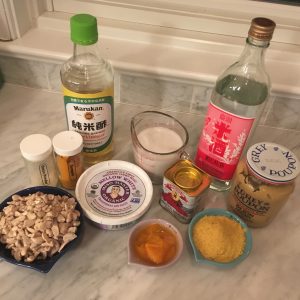
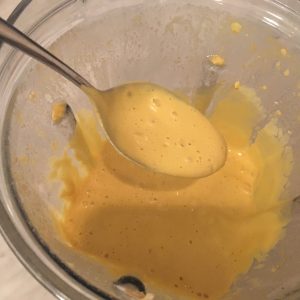
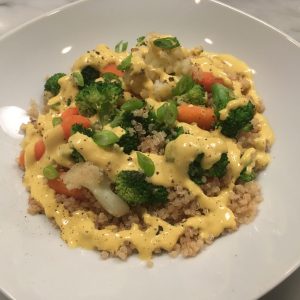
A couple nitpiks: Recipes labeled with cheesy names have to taste cheesy – nooch just doesn’t taste cheesy to me. And there isn’t any nutritional info – I’d like to know the calorie count and the percentage from fat – is it a 30-cal tablespoon or a 125 cal one? Also while the cashew craze has been well addressed, alternatives would be appreciated (since cashews are high-FODMAP) and a little more on aquafaba would also be helpful and suggestions for those among us who choose oil-free.
Bottom line – this book is a keeper. There are enough interesting concepts in here to encourage experimentation. It is not haute cuisine, but it is reliable, tasty, clean vegan. And that’s worth a lot.
Farmacology – What Innovative Family Farming Can Teach Us About Health and Healing
by Daphne Miller, MD. 2013 HarperCollins Publishers. List $23.95 HC $20.16, PB $14.22, Kin $10.99
One of the more interesting overviews of the relationship between health and farming, Farmacology explores the revitalization of agriculture as a metaphor for integrative approaches to medicine as the author looks for solutions for her most difficult cases. At times, Dr. Miller (A San Franciscan integrative medicine physician) stretches the conceit but I didn’t mind because she took us on one of the best journeys through revisionist agriculture that I have read. Everything old is new again. Miller visited seven farms, beginning with author/farmer Wendell Berry’s fabled homestead – where Berry helped her to construct the parameters for her search.
With a humble beginners’ mind, Miller visited an Ozark ranch, a Washington state biodynamic farm, a pair of side-by-side organic chicken egg farms that used different approaches, a set of long-lived Bronx community gardens, a vineyard and an herb farm. Each eschewed, to some degree, the green revolution’s factory farming inputs in favor of returning to the more environmentally sensitive approaches that predated the arrival of post-war pesticides and chemical fertilizers. With each investigation, Miller related the lessons learned on that farm with potential solutions for a particularly challenging patient Sometimes, the comparisons didn’t really work but other times they were viable and insightful. Two stand out: a vineyard’s pest-management approach paralleled innovative thoughts on treating cancer and the process of rejuvenating the soil suggested useful tactics for reassessing and reclaiming our own bodies.
Probably the most endearing chapter was the one about the two egg farms – both owned by a father and son team. This was a bit of an experiment for them. One farm met all the requirements for organic eggs and the other went considerably further and actually delivered organic, truly pastured eggs. They discovered that the pastured eggs were of considerably higher quality but the output was, surprisingly, somewhat lower. The pastured farm also demonstrated the community nature of hens – how much they love a good gossip and hanging out with special friends (this chapter was related to stress-management). The other interesting note – for those who eat eggs – is that organic doesn’t mean pastured – all you need is an open door someplace and a small cement pad for the thousands of chickens house in that multi-level, window-less barn. When you understand the flock nature of chickens, Tyson’s approach becomes even more deplorable.
Farmacology is an easy read that delivers a wealth of thought-provoking information.
Project Animal Farm: an accidental journey into the secret world of farming and the truth about our food
by Sonia Faruqi. 2016 Pegasus Books List $27.95, HD $19, PB $16.95, Kin $14
Ms. Faruqi, a former Wall Streeter, decided to volunteer at a Canadian organic dairy farm and that started an international journey to explore animal agriculture. Her up-close and personal experiences – from Canada to Indonesia, Malaysia, Singapore, Dubai, Mexico, Belize, and finally the US – are interspersed with relevant facts and figures about animal farming. A focused, topic-specific memoir (with extensive references) as opposed to a traditional investigative reporting piece, it is nevertheless a compelling read. The distressing, horrendous descriptions of a world gone horribly awry are lightened by a very few rays of hope. Ms. Faruqi concludes with the following solutions (which she has demonstrated throughout the book): 1. Large pastoral farms – reflecting crucial economies of scale – are the future ideal. 2. Genetic selection has created animals that are unable to function properly promulgating unnatural behaviors. 3. Gender diversity among famers needs to increase – more women!! 4. Agribusiness needs to police itself, recognize the obvious problems and create solutions. 5. Farm inspections need to be done by independent third parties. 6. Farm animals need regulations that recognize they are sentient beings and treat them as such (see #5). 7. Labels have to make sense and be enforced – for instance, the label “organic” (theoretically the most specific and meaningful term) is often achieved with lip service, blatant abuse and loopholes (see #5).
Eating Plant-Based in the British Virgin Islands
Provisioning for a whole foods, plant-based diet is pretty easy in the BVI if you are on a charter yacht or staying in a villa. On Tortola, recently renovated Rite-Way about a quarter mile from the Moorings Charter Yacht Base (the largest in the world) has a good assortment of grains, beans, produce, some frozen veg entrees, soy milks and Bobby’s even has local tofu. You can buy home-made hummus at the Patisserie on the Moorings entrance road – and until recently they had a fab tofu salad (we keep asking when it’s coming back). There are tubs filled with a variety of pickles (delicious cornichons) and lots of olives. Even the little market in Leverick Bay Resort & Marina on Virgin Gorda – on the southern edge of North Sound – has frozen vegan entrees.
But if you wish to dine out, and have the full BVI experience, then things get a bit more challenging. Vegetarian is, of course, easier because chefs sub cheese for meat. It seems the higher end restaurants are beginning to recognize the sea change (and, of course, the Rasta eateries and stands are always ready with a quick meal). But we have ferreted out a few places that offer a lovely ambiance, spectacular views and offer at least one whole food, plant-based app and one entree right on the menu.
Saba Rock Resort in North Sound is accessible by their ferry from Leverick Bay or Bitter End Yacht Club or by dinghy from your boat moored right off this one-acre bit of paradise. Rooms are simple and immaculate and the menu offers several vegan entrees: For lunch at The Pub, try three black bean crispy tacos ($16.95) , Black Bean Veggie Burger ($14.95) or a vegetarian traditional West Indian Curried Roti. Everyday from 4-6pm, it’s Happy Hour with $2.50 Painkillers, Rum Punch & Carib Beer. For dinner, there’s an all-you-can-eat buffet that features a fresh salad bar and a wide range of hot entrees ($29.95) check to see if they’re vegan offerings that night. Among the a la cart entrees is a dinner size West Indian vegetarian Roti ($29.95) or Cuban-style Fire-Roasted Vegetarian Kebobs ($27.95) featuring mini black bean cakes – accompanied by the salad bar. Tables are literally right on, actually over, the water – so it’s easy to watch the large schools of Tarpon circling the underwater lights or look across the bay filled with yachts on moorings. Contact – (284) 495-9966 or VHF Ch. 16.
Just across the Sound, the famous Bitter End Yacht Club resort is not so accommodating – and that was a bit of a shock. There are four eateries. We ended up with Conch Fritters on the premise that there is so little conch in conch fritters that it was irrelevant – and we needed something to sop up the wine and beer. They might have been able to rustle up a simple salad or a steamed/grilled veggie plate or white pasta with red sauce had we asked, but there is nothing on their menu that works (even modified) and we just weren’t up for another heavily oiled, uninspired veggie plate or pricey but lackluster pasta with tomato sauce from the kids menu – no matter how gorgeous the view. But if you are looking for fresh bread and other bakery items for the galley – head to Winston’s.
Around the corner, Leverick Bay offers three dining options. Chef George’s upper level fine dining room offers a tomato and mozzarella salad ($15) or Bruschetta ($11) that can be made without the cheese. For an entree, there’s a Creamy risotto, beurre blanc, seasonal vegetables and aged balsamic topped with crispy carrots (leave out the cheese and/or buerre blanc). The Cove and Bar offer more veg friendly options: Garden Salad ($12) or Hummus and pita chips ($12) to start followed by a Veg Pizza (skip the cheese $19). Entertainment is excellent. Michael Bean’s pirate bit Mon-Wed 5-7 pm is always well-attended and a family fave. We spent a week in their mooring field and never tired of his bits). Friday night’s the Beach BBQ (we found lots to eat on their vegetable forward buffet) that features the must-see Moko Jumbie Dancers and Thursday nights it’s the Salt and Pepper Shakers.
Around the corner, at Biras Creek Resort, we really loved the Fat Virgin’s Cafe overlooking the dinghy dock. Brightly colored picnic tables were awash in local specialties – so we always found something delicious to eat. Sadly, Biras Creek closed – we don’t know for how long or what happened to the cafe – so call.
Overlooking Manchioneel Bay, private, secluded laid-back Cooper Island Beach Club (accessible via their private ferry from Road Town or dinghy in from the mooring field) has been one of our all-time family favorites – and it just keeps getting better and better. But it’s been sooo discovered that getting a mooring requires a first-light run. The chef offers a Roasted Garlic Hummus Wrap with artichoke hearts and Cajun fries ($11) on their lunch menu. Unfortunately their Traditional West Indian Roti, which our son rates very highly, is made with chicken (maybe they will offer a veg alternative soon). For dinner they offer hummus as a starter and Penne with sauteed vegetables and a pesto-tomato Sauce ($20) as an entree. Another possibility, Eggplant Rolls filled with goat cheese and red peppers ($19), might be doable without the cheese. We understand that they will also accommodate gluten-free, so this seems a very real option. Happy Hour is 4-6pm with two for one drinks. Rooms are available at the Beach Club or around the island at Cooper Island Villas.
Vegetable Rotis, like the ones served at Saba Rock, are an authentic taste of the Caribbean that originated in Trinidad. It’s a a large flatbread filled with curried meat, fish or vegetable – kind of like a huge burrito. We are always on the look-out for the vegetable versions, not too hard to find, and one of the very best is served at the little Roti Palace, tucked behind Samarkand Jewelers on Old Main Street, Road Town Tortola ($10-25 for lobster). There’s a little dining area and an outdoor patio – or take-out. (They’re hand-made so be prepared to wait a bit.) If you want to be 100% sure there is no chicken or fish stock in your roti, look for a Rastafarian restaurant that serves I-tal food – which is strict vegetarian.
Pirates Bight Restaurant on Norman Island re-opened in December 2012 with a beautiful, brand new, larger facility. The dinner menu features a “Vegetarian’s Delight” ($28) that changes daily – hopefully their delicious West Indian Vegetable Roti filled with traditional curried spiced vegetables will be on the rotation. There’s also a trio of veggie salads: Greek Bounty salad – sliced tomatoes, cucumbers, feta cheese, olives, with fresh pita and home made hummus ($16), Garden ($13 ) and Fruit platter ($12). It appears that lunch is no longer served (there used to be a vegan roti, veggie burger topped with grilled pineapple, fresh tomato, lettuce and onions, and grilled veg panini). Thursday through Sunday, the music starts at 8 pm (and Wednesday is Karaoke). Happy Hour is 4-6 pm; the bar menu offers chips and salsa ($10), sweet potatoes and tania chips ($10), french fries ($10) and onion rings ($10).
Also in The Bight, just off Norman Island, the infamous floating “Willy T” (aka The William Thornton) serves Lunch (12-3 pm) and Dinner (6:30-9 pm) and offers a Veggie Burger ($9), along with fries/rice and coleslaw. They’ll also rustle up a simple romaine salad since it is the base for their meat and fish salads. Diving off the top deck (clothed or not) is a long-time tradition.
At Tortola’s West End in Sopher’s Hole, The Jolly Roger has been totally reinvented as the open-air Fish ‘n Lime Inn & Restaurant . For lunch Heather’s Mandarin & Cashew Salad, hold the feta ($16) and/or Hot Spinach and Avocado Cheesecake ($15) and for dinner Risotto Balls ($15) and Heather’s salad – no vegetarian entree option.
Other possibilities include: Mellow Moods Cafe, an Ital eatery at the Road Town round-about, Chic Gourmet at Fish Bay, Nature’s Way in Mill Mall also in Road Town (run by Seventh Day Adventists), gorgeous top of the pack Sugar Mill offers rotating vegetarian selections at lunch and dinner (min $35/pp count on $60/pp at dinner) and also offers Gluten free and two-for-one drinks as you watch the sunset.
What did we miss?
Maui – On the Road to Hana
We decided to drive the supposedly totally off-the-beaten-track but spectacular Road to Hana along Maui’s northeast coast. The warnings were universal – take lots of water and food, gas up the car – there’s nothing along the whole route – perhaps 55+/-miles with 58 bridges (many one-lane wide) and over 250 serious curves – plus untold vistas and one-car-wide pull-offs. So the estimate is about 4 hours to get to Hana and as long to get back – with stops at the top five attractions. The warnings also advised against taking the “dotted line” road back to Wailea that would complete the circuit – so we had to come back the same way or void our car rental agreement if we were found out…
Consequently, we wasted a good hour getting prepared for this major odyssey in our little fire-engine red convertible – about half the rentals in Maui are convertibles and most of them were headed to Hana at the same time we were. Many of the warnings proved over the top or just plain wrong. Except one – there are 58 bridges, most one-lane wide – and over 250 curves – so no wine and beer on this trip. But were were happy that we had provisioned at Down to Earth – an organic, all natural market just south of the Hana Road that makes delicious plant-based sandwiches ($7.99 each) – subs and wraps – and offers a wide range of “healthy” chips, drinks and well-priced water. downtoearth.org.
The drive was made far more interesting because we rented a GyPSy GPS program that provided fascinating commentary on what we were passing or stopped at – along with a lot of history and anecdotes during the long stretches of gorgeous scenery.
Our experience was that there are services along the way – but maybe not year round – so check. There’s a small cluster of shops and snack bars, tiny family-run roadside stands – some offering fruit, vegs, burgers or pastries. And there is a gas station in Hana along with some basic dining options, an “historic General Store” that has seen better days, and a resort. FYI: several people told us later that the “dotted line road,” which would have made this an even more interesting drive, is just fine at this time of year and we should have taken it.
For images of the Road to Hana, please see this link to Pinterest.
